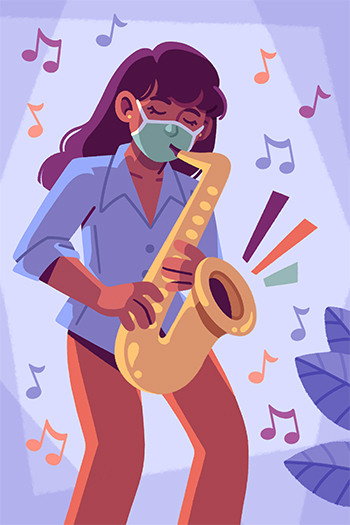- Apply
- Visit
- Request Info
- Give



Published on December 09, 2020

Illustration by Mekaila Stefano '20
No industry has adapted to COVID-19 quite like the performing arts. With venues shuttered and musicians quarantined, an experience once universally live and in-person now streams virtually to a dispersed audience who watch via computer screens and cellphones. It’s been a dramatic turn of events, but as the Music Program at Eastern Connecticut State University demonstrated in fall 2020, the new performance “space” has tested the character of musicians and come with developments that will leave the industry changed forever.
Despite restrictions in response to the pandemic, the Music Program was able to pull off a near full slate of concerts and recitals this fall — in some cases, to wider audiences than ever before. Music students continued their lessons through a mix of hybrid and on-ground classes and presented their work using a range of technological approaches. And performing arts faculty and staff developed new systems that make their programs more resilient moving forward.
All of the Music Program’s 12 instrumental and vocal ensembles were active this semester. The size of each ensemble determined whether the students could gather in person for rehearsal and performance. (For singers, horns and woodwinds, 12 feet — not six — is the recommended physical distancing guideline.) Smaller ensembles, such as the Jazz Combo and Percussion Ensemble, could gather synchronously, while larger groups like the Concert Band and Concert Chorale exclusively conducted activities remotely.
“As you can imagine, running ensembles in an asynchronous manner has been a real challenge, and not being able to showcase student work by way of public performance has caused us to be creative,” said professor David Belles, who directs the Concert Chorale and Eastern Chamber Singers. “We’ve had to be very creative and catch up on technology that we ordinarily don’t use in acoustic live performance.”
For their performance of “I Carry Your Heart in Me” by composer David Dickau, the 38 vocalists in the Concert Chorale recorded their parts separately while following a guide track. The individual audio/video recordings — often captured with cellphones — were then mixed and mastered into a finished performance, produced by a company called Arts Laureate and uploaded to YouTube.
The instrumentalists in the 25-person Concert Band used the same approach for their performance of “A Song for Tomorrow” by composer Kevin Day. “This was perhaps the most non-traditional semester the Eastern Concert Band has seen in its 40 years of existence,” said ensemble director Kelly Watkins, “but through it all we found ways to learn, grow and make music.”
The majority of productions this semester were produced in-house in collaboration with Media Services and staff in the Fine Arts Instructional Center (FAIC). Virtual performances were either presented via livestreaming or prerecorded and premiered online, depending on the size of the ensemble and need for editing. The Music Program’s already robust YouTube channel served as the streaming platform of choice.
Throughout the semester Sheila RuJoub, FAIC events coordinator, has been monitoring the YouTube channel’s viewership, “which has really been my barometer on whether or not our virtual events have been reaching our normal audience,” she said. “As the semester went on and we polished our format, not only did views rise, but we’ve had an overall boost in subscriber count by margins we haven’t seen before, so our audience is definitely adapting with us.
“We’ve really gotten to a point where we can make all these limitations work for us,” said RuJoub. “Our spring semester is looking to be much fuller since we know what we’re working with now.”
Even when the pandemic subsides, these new capabilities are important for the Music Program — and the industry at large — moving forward. “I think live broadcast is part of the future for all performing arts,” said lecturer and accompanist David Ballena. “This pandemic has forced us to move in that direction in a much faster way. It’s been a steep learning curve for everyone, but a necessary one.”
Explaining the benefits of live broadcast, Ballena said, “My mom and other relatives were able to watch my faculty recital live in Peru through YouTube. The same is true for our out-of-state students, whose friends and relatives may not have heard them perform in a long time, if ever at all.”
Ballena says the video recordings are good for the performers as well, as they can review the videos and learn from watching themselves play.
This emphasis on video production and sound engineering is also resulting in new professional opportunities for students. Music and new media studies double major Christiana Montalbano, who performs in several vocal and percussion ensembles, had an integral role in the video editing process for the majority of the percussion concerts.
She set up the recording equipment, retrieved the video recordings from cell phones set at different angles, then used DaVinci Resolve software to sync the videos with the master audio. “Once the videos were synced with the mixed audio, I got to be creative and choose what video would play at certain points in the piece,” said Montalbano.

The Music Program’s innovative and successful semester has not come without its toll on the musicians, as the need for social distancing has hampered the camaraderie and thrill of live performance across the entire performing arts industry.
“Studying music can be a lonely endeavor at times,” said music major and trombonist Hannah Avena. “You spend hours each day in a practice room and spend a lot of time with yourself. This can be great in teaching patience, discipline and other values. However, it can certainly be challenging in an already isolating COVID era.”
Avena found solace in her daily visits to the FAIC, where she reserved a practice room through the building’s new online reservation system. “Just having somewhere to go, a place that isn’t your room, is a luxury that not everyone has. School felt more normal to me because I was still making that walk every day and seeing students and faculty around.
“The Music Program at Eastern is made up of a wonderful group of people that certainly make this hard time easier,” added Avena. “I’m grateful to have something bigger than myself that I can work toward every day, distracting me from the craziness around us right now.”
Through the experience of performing in isolation, students have reported the need to develop self-sufficiency and affirmation, as the audience is not present to provide feedback. “Music and performance is such a communal activity,” said Montalbano, “and it’s been challenging and a little disheartening to not have normal in-person concerts this semester. However, I’m grateful for the flexibility and adaptability we’ve all shown.”
Music professor and program coordinator Okon Hwang congratulates students for their efforts in this trying semester: “I am very proud of the way our students persevered,” she said. “Needless to say, this semester has been full of challenges. But our students in general were fully engaged regardless of the modality they had to deal with.”
Even with a curriculum bolstered by virtual capabilities and a campus modified for the pandemic, the Music Program will certainly welcome an eventual return to normal.
As Avena puts it: “I will never take another live performance for granted. This experience has helped me realize the importance of the arts and of live performance, and how lucky I am to have had the opportunity to participate in it devoid of COVID.”
Written by Michael Rouleau